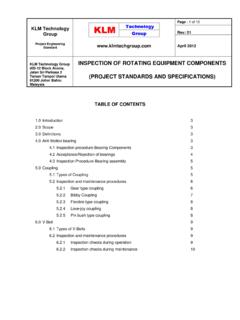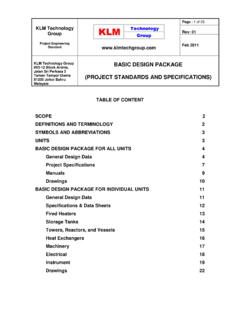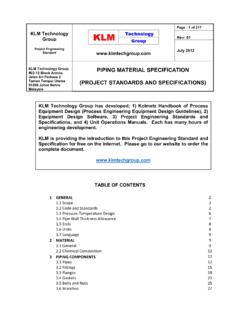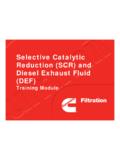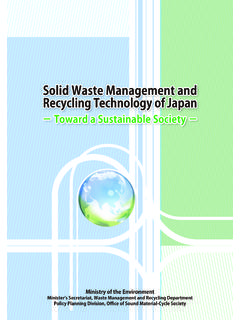Transcription of PROCESS DESIGN OF WATER SYSTEMS (PROJECT …
1 KLM TechnologyGroupProject :1of65 Rev: 01 April2011 KLM Technology Group#03-12 Block Aronia,Jalan Sri Perkasa2 Taman Tampoi Utama81200 Johor BahruMalaysiaPROCESS DESIGN OF WATER SYSTEMS (PROJECT STANDARDS AND SPECIFICATIONS)TABLE OF CONTENTSCOPE2 REFERENCES2 DEFINITIONS AND TERMINOLOGY2 SYMBOLS AND ABBREVIATIONS7 UNITS8 WATER TREATMENT SYSTEM8 General8 Processes-Design16 RAW WATER AND PLANT WATER SYSTEMS35 DESIGN -General35 COOLING WATER DISTRIBUTION AND RETURN SYSTEM40 DESIGN -General40 DESIGN Criteria41 APPENDIX A42 APPENDIX B44 APPENDIX C46 APPENDIX D49 APPENDIX E50 APPENDIX F53 APPENDIX G58 APPENDIX H59 KLM TechnologyGroupProject Engineering StandardPROCESS DESIGN OF WATERSYSTEMS (PROJECT STANDARDS ANDSPECIFICATIONS)Page2of65 Rev: 01 April2011 SCOPEThis Project Standards and Specificationsspecifies the minimum requirementsfor the PROCESS DESIGN and selection of various WATER supply SYSTEMS , used inOGP IndustriesREFERENCEST hroughout this Standard the following dated and undated standards/codes arereferred to.
2 These referenced documents shall, to the extent specified herein,form a part of this standard. For dated references, the edition cited applies. Theapplicability of changes in dated references that occur after the cited date shallbe mutually agreed upon by the Company and the Vendor. For undatedreferences, the latest edition of the referenced documents (including anysupplements and amendments) (Amrican Boiler Manufactures' Association) (American Society of Mechanical Engineers) (American WATER Works Association, Inc)---" WATER Treatment Plant DESIGN ", 1971 Manual M21,"Ground WATER ", Latest (American Petroleum Institute)---"API Glossary of Terms Used in Petroleum Refining", 2nd.,Ed., (Gas Processors Suppliers Association)---"Engineering Data Book", Section 18, (US Public Health Service)---"Drinking WATER Standards", No.
3 956, 1962 DEFINITIONS AND TERMINOLOGYFor the preparation of the following definitions, "API Glossary of Terms Used inPetroleum Refining", and DCC, "Principles of Industrial WATER Treatment", havebeen acid neutralizing capacity of a WATER . It is usually expressed as"M" alkalinity (the methyl/orange endpoint at a pH ) and "P" alkalinity (theKLM TechnologyGroupProject Engineering StandardPROCESS DESIGN OF WATERSYSTEMS (PROJECT STANDARDS ANDSPECIFICATIONS)Page3of65 Rev: 01 April2011phenolphthalein endpoint at a pH ). Several ions contribute to alkalinity, butit is generally dueto bicarbonate (HCO)-1, carbonate (CO3)-2 and hydroxyl(OH)-1 part of the operating cycle of an ion-exchange PROCESS whereina reverse upward flow of WATER expands the bed, effecting such physical changesas loosening the bed to counteract compacting, stirring up and washing off lightinsoluble contaminants to clean the bed, or separating a mixed bed into itscomponents to prepare it for Expansion-The effect produced during backwashing; the resin particlesbecomesseparated and rise in the column.
4 The expansion of the bed due to theincrease in the space between resin particles may be controlled by regulatingbackwash is the continuous or intermittent removal of some of thewater in the boiler or cooling WATER system to reduce concentration of dissolvedand/or suspended WATER -A term construed to mean a representative sample of thecirculating boiler WATER , after the generated steam has been separated, andbefore the incoming feed WATER or added chemical becomes mixed with it, so thatits composition is Chlorination-The addition of chlorine to WATER to the point wherefree available residual chlorine increases in proportion to the incremental dose ofchlorine being added. At this point all of the ammonia has been WATER - WATER having a dissolved matter content in the range ofapproximately 1,000 to 30,000 first appearance in the solution flowing from an ion-exchange Unit of unadsorbed ions similar to those which are depleting theactivity of the resin bed.
5 Breakthrough is an indication that regeneration of theresin is having more than approximately 30,000 mg/L of dissolved Residual-The amount of available chlorine present in WATER at anyspecified period, subsequent to the addition of TechnologyGroupProject Engineering StandardPROCESS DESIGN OF WATERSYSTEMS (PROJECT STANDARDS ANDSPECIFICATIONS)Page4of65 Rev: 01 April2011 Chlorine Requirement-The amount of chlorine, expressed in mg/kg, requiredto achieve under specified conditions theobjectives of precipitation from solution or suspension of fine particleswhich tend to unite in clots or lost from a WATER -cooling tower as liquid droplets entrained in theexhaust air, units: kg perhour or percent of circulating WATER WATER supplied to a boiler to make-up for small, tufted, or flakelike mass of matter floating in a solution, , asproduced by WATER - WATER having less than approximately 1,000 mg/L of characteristic of WATER generally accepted to represent the totalconcentration of calcium and magnesium chemical PROCESS involving the reversible interchange of ionsbetween a solution and a particular solid material (ionexchanger), such as an ion-exchange resin consisting of matrix of insoluble material interspersed with fixedions of opposite s Index-A technique of predicting whether WATER will tend to dissolveor precipitate calcium carbonate.
6 If the WATER precipitates calcium carbonate,scale formation may result. If the WATER dissolves calcium carbonate, it has acorrosive tendency. To calculate Langelier s Index, the actual pH value of thewater and Langelier s saturation pH value (pHS) are needed. Langelier ssaturation pH value is determined by the relationship between the calciumhardness, the total alkalinity, the total solids concentration and the temperature ofthe WATER . Langelier s Index is then determined from the expression pHpHS. is a chart used for determining Langelier s Index. The interpretation of theresults obtained are shown below:pH-pHSTendency of WaterPositive ValueNegative ValueZeroScale FormingCorrosiveNeither Scale Forming NorCorrosiveKLM TechnologyGroupProject Engineering StandardPROCESS DESIGN OF WATERSYSTEMS (PROJECT STANDARDS ANDSPECIFICATIONS)Page5of65 Rev: 01 April2011 Fig.
7 1 Langeller Saturation Index ChartKLM TechnologyGroupProject Engineering StandardPROCESS DESIGN OF WATERSYSTEMS (PROJECT STANDARDS ANDSPECIFICATIONS)Page6of65 Rev: 01 April2011 Also note that the presence of dissolved oxygen in the WATER may cause waterwith a "Zero" Langelier s Index to be corrosive rather than "neutral".Caution must be observed in employing Langelier s Index for controllingcorrosion or deposit formation, since there are factors that may make itsapplication inappropriate. These include temperature differences within a system ,changing operating conditions, or the presence of chemical treatment in WATER -Untreated Rate-The flow of cooling WATER being pumped through the entireplant cooling solution used to restore the activity of an ion exchanger.
8 Acidsare employed to restore a cation exchanger to its hydrogen form; brine solutionsmay be used to convert the cation exchanger to the sodium form. The anionexchanger may be regenerated by treatment with an alkaline polymer of unsaturated hydrocarbons from petroleum processing, ,in the cracking of petroleum oils, propane deasphalting, clay treatment ofthermally cracked naphthas. Chief uses include:-rubber and plastics;-impregnants;-surface operation which followsregeneration; a flushing out of excessregenerant Stability Index-An empirical method for predicting scaling tendenciesof WATER based on a study of operating results with WATER of various Index = 2pHS-pH(Eq. 1)Where:pHS = Langelier s Saturation index is often used in combination with the Langelier Index to improve theaccuracy in predicting the scaling or corrosion tendencies of a WATER .
9 Thefollowing chart illustrates how to use this index:KLM TechnologyGroupProject Engineering StandardPROCESS DESIGN OF WATERSYSTEMS (PROJECT STANDARDS ANDSPECIFICATIONS)Page7of65 Rev: 01 April2011 RYZNAR STABILITY INDEXTENDENCY OF ScaleLight ScaleLittle Scale or and higherCorrosion SignificantHeavy CorrosionCorrosion IntolerableSynthetic Resin-Amorphous, organic, semisolid or solid material drived fromcertain petroleum oils among other sources; approximating natural resin in manyqualities and used for similar area of the settling basin, in (m ).ABMAA merican Boiler Manufacturers Petroleum Society of Mechanical WATER Works capacity of the resins expressed in(French degrees/L per liter of consolidated resins).DIND eutsches Institute Fur Normung WATER Processors Suppliers Contaminant Possible , Gas,and Saturation per million by mass, in (mg/kg).
10 QInflow rate, in (m /h). concentration of salts of strong acids, in[French degrees (SO4-2+ Cl-1+ NO3-1)].sp grSpecific Gravity (Relative Density).TACC omplete Alkalinity of carbon dioxide in the WATER after passingthrough the cation exchanger, in (French degrees).TSiO2 Silica content (1 French degree = 12 mg/L SiO2based on Table ).USPHSU nited States Public Health TechnologyGroupProject Engineering StandardPROCESS DESIGN OF WATERSYSTEMS (PROJECT STANDARDS ANDSPECIFICATIONS)Page8of65 Rev: 01 April2011 VVolume of WATER to be supplied in (m ).vVelocity of settling, in (m/h).VaVolume of anion of cation rate, in (m/h).VpDownward velocity, in (m/h).UNITSThis Standard is based on International system of Units (SI) except whereotherwise TREATMENT SYSTEMG eneralWater treating requirements for refinery and/or plant services depend upon:-the quality of the source of make-up WATER ;-the manner in which the WATER isused;-environmental regulations.

